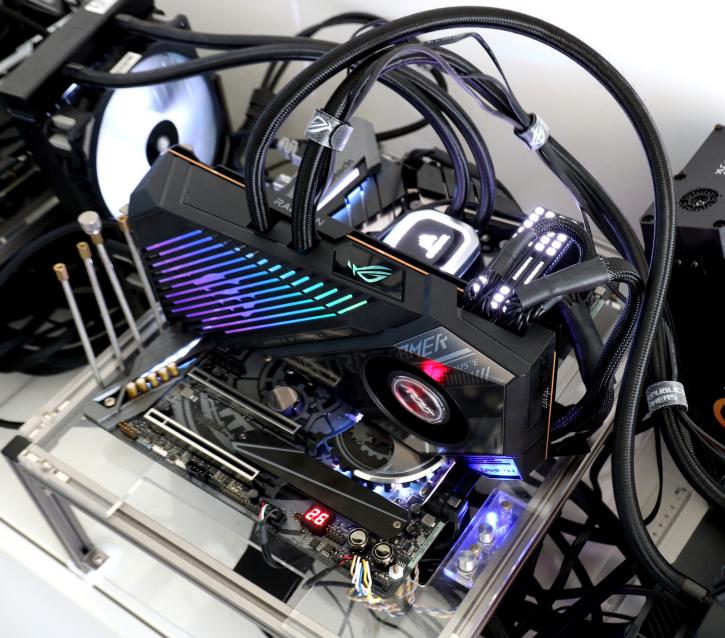Final words and conclusion
Final words
Ultimately everything and anything it's all about gaming price, performance, and, of course, rendering quality. Of course, the Radeon RX 6800 XT is a product that ticks the mandatory boxes. We do feel a potential 6800 offers more value for money. But man, ASUS did well with this one regarding perf, tweaking, cooling, and acoustics. This card can run games at 4K; it will serve extremely well at WQHD and with brutally GPU bound games. At Full HD, you'll be quite often bottlenecked and CPU limited, but compared to NVIDIA's RTX 3080 and even 3090, AMD's L3 cache brings them some speedy performance. Competition wise you're looking at 3080 levels of performance for the 6800 XT overall. Performance-wise we can safely state that this is a true Quad HD graphics card that is very Ultra HD capable of the current games. However, AMD's biggest deficit is that they do not have a solution at hand that matches DLSS from NVIDIA. The added Tensor cores in hardware on the RTX series will always work out better for NVIDIA. Even with DirectML support pending, these still need to be run over the compute engine. So no matter how we look at it, it'll cost performance, whereas NVIDIA can offload its ML supersampling to the tensor cores. It's the sole reason why they implemented these specific DL/AI cores in the first place.
Cooling & noise levels
The series offers good results in even stressed conditions, all thanks to the LC cooler, of course. Performance mode hits 37 DBa, and while not noisy, you can hear it. Ergo, enable that silent mode as performance-wise, it is not going to make a difference. You then hover at only 33 DBa measures at 40cm distance. Temperatures are also a bit trivial in the two BIOS modes. I mean, ~53 C is lovely for that PERF BIOS mode to offer, but is 58~59 Degrees C considered evil for SILENT mode? We doubt that very much, so again silent BIOS mode is the preferred choice. FLIR imaging shows the card is hardly bleeding heat, but a bit more so in silent mode (which can be expected). Overall, we're very comfortable with what we observe.
Energy
Heat output and energy consumption are closely related to each other, as (graphics) processors and heat can be perceived as a 1:1 state; 250 Watts in energy consumption equals close to 250 Watts in heat as output. This is the basis of TDP. AMD is listing them at 250 (6800) to 300 (6800 XT) Watts for the flagship product, which is okay for a graphics card in the year 2020 at this performance level. We measure numbers to be close to the advertised values for the XT. We measured 335 Watt while gaming; that's total board power, not TGP.
Coil whine
The ASUS card, much like any other card these days, does exhibit coil squeal, moderate amounts of it. Is it annoying? It's at a level you can hear it for sure. In a closed chassis, that noise would fade away in the background. However, with an open chassis, you can hear coil whine/squeal. Graphics cards all make this in some form, especially at high framerates; this can be perceived. It was louder for the STRIX than the other cards we have tested; we think the coil whine resonates a bit inside that cooler, being amplified. So at 33 DBa, we could not hear the fans, but some coil whine is definitely there.
Pricing
Limited availability and nauseating price levels these days for a graphic card are becoming bothersome. I mean, even for us true hardcore PC gamers, it's getting more and more difficult to explain why people should put down this much money to be able to play computer games on a PC. I mean, the spread is $999 for the 6900 XT, $649 for the 6800 XT, and $579 for the cheapest 6800 model based on the reference design. The STRIX OC LC has a 250 USD price premium coming from that reference design. It's steep TBH, but hey, you pay extra for a premium design being LC-based and that factory tweak. We'll have to wait and see how that pans out, though, as everything is even more so dependent on these cards' actual volume availability.
Tweaking
AMD does enforce cap again on the memory; we don't like that as we feel we could have gone a notch further. Results will vary per board, brand, and even card due to cooling (GDDR6/GPU/VRM), and where we'd hit 2500 MHz (stable) on cards like the Sapphire and XFX ones, the STRIX LC seems to be a bit of a tweaking marvel. Your power limiter is the decisive and dominant factor; lowering or increasing the power budget allows for higher framerates. However, we could apply 2700 MHz, without anomalies and crashes whatsoever. Depending on load, game/app, and board assigned power, we now see the dynamic clock frequency hovering in the 2675 MHz range. That's pretty damn impressive. All that tweaking and extra energy consumption will bring you a max of ~5% extra performance at best, but seen from reference; you just gained roughly 10% perf in Ultra HD gaming. Also, and let me reiterate this, for an overclock to be successfully listed here, it needs to pass 4 game runs (different games) in ultra HD to be deemed stable.
Conclusion
ASUS unleashed a bit of a devil here. Granted, performance among all premium boards is the same with perhaps a 1% differential and roughly 4% over the reference design. However, that reference card has an MSRP of 649 USD, which needs to be the baseline. Performance aside, your purchasing choices will more be based on acoustics, extra features, temperatures, aesthetics, and pricing, of course.AMD outed their 6800 series in November 2020, and aside from troubled launch availability wise, the cards did manage them to be where they need to be, which is NVIDIA territory. Technologies like raytracing are now becoming a norm for gaming. With Big Navi, aka the 6800 and 6900 series, AMD is back to the table with a deck of cards that offers support for that full DirectX Ultimate feature set. Not just that, they've made some big bets with the architecture. The infinity cache definitely brings them where they need to be performance-wise. You can see that the L3 cache hit rate works really well for them in 1920x1080 up-to 2560x1440. However, at Ultra HD, these cards slow down a notch, likely due to GDDR6 memory being used on that 256-bit wide memory bus. But even there, the cards remain extremely capable and is a UHD class graphics card. The STRIX LC is an absolute top pick; the design works well aesthetically, acoustically, and temperature-wise. Next to that, you'll have some better OC potential available compared to the other cards we tested. The Dual BIOS is nice as a fail-safe, but place it in silent BIOS mode and never look back. The tweaking performance on this board really managed to impress me. Downsides, well, pricing is just mad, the fan cabling could have been done a bit nice sleeved or running inside that tubing sleeve, and yep, this card exhibits very noticeable amounts of coil whine. But as far as RX 6800 XT cards will come and go, this one is ranking high up on that premium list. Your challenge, should you choose to accept it, is however to find one in the stores. Then again, if at one point it does, you can make an informed decision based on the review here.
Sign up to receive a notification when we publish a new article.
Or go back to Guru3D's front page
- Hilbert, LOAD"*",8,1.



